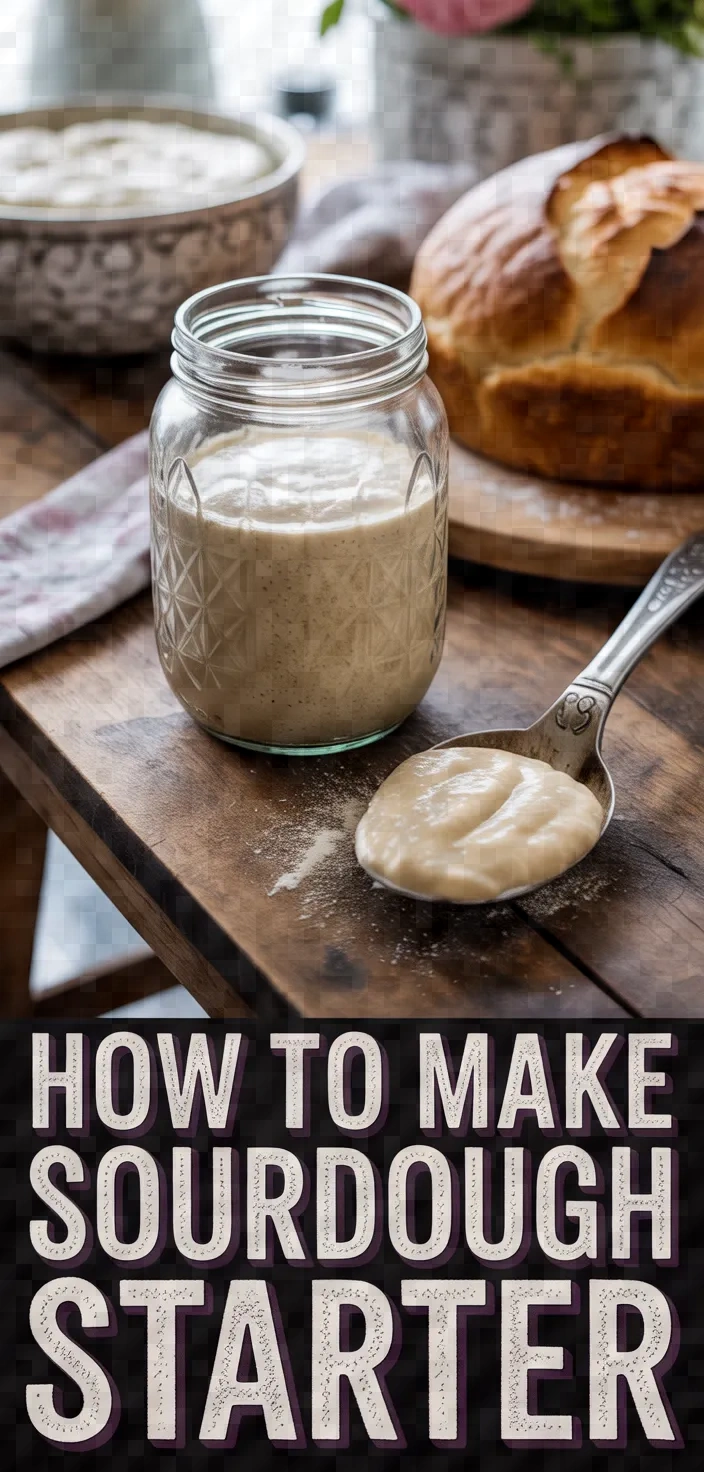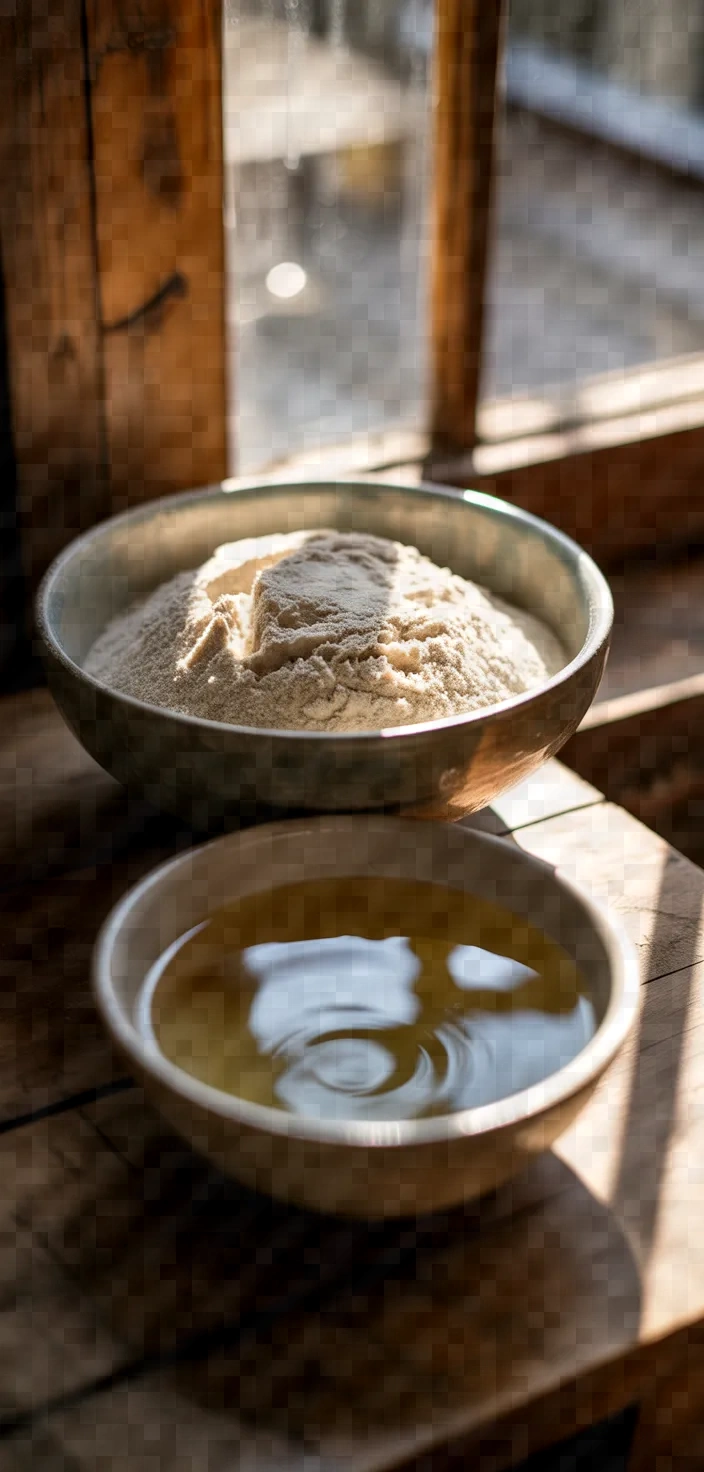How To Make Sourdough Starter Recipe
I can’t wait to make my own sourdough starter cuz it’s kinda wild how a simple mix of flour and lukewarm water suddenly turns into this bubbling, lively thing that feels almost magical in my kitchen.

I love makin my sourdough starter because when you mix nutritious unbleached flour with lukewarm filtered water around 70°F it feeds the natural microbes that break down starches and release essential enzymes. I think the balanced mix gives you needed protein and fiber for a strong starter.
Ingredients

- Unbleached all purpose flour supplies complex carbs, protein and fiber for robust yeast activity.
- Its natural nutrients ensures a thriving and tangy sourd
Ingredient Quantities
- 100 grams unbleached all-purpose flour (you can mix in a little whole wheat or rye if you’re feelin adventurous)
- 100 grams lukewarm filtered water (around 70°F, perfect to help wake up those natural microbes)
How to Make this
1. In a clean jar or bowl, mix 100 grams of unbleached all purpose flour and 100 grams of lukewarm filtered water (around 70°F) until there is no dry flour left, you can mix in a little whole wheat or rye if you feel adventurous.
2. Cover the container with a cloth or lid that is loose enough to let air in but stops dust or bugs from getting inside.
3. Leave the mixture at room temperature for about 24 hours.
4. After 24 hours, check for small bubbles or a mild sour smell; if nothing happens dont worry its common for some starters.
5. Stir the mixture well then discard about half of it to make room for feeding.
6. Feed the remaining starter with another 100 grams of flour and 100 grams of water, stirring until you reach a consistency similar to pancake batter.
7. Repeat the feeding process once every 24 hours, stirring each time, until the starter becomes bubbly and doubles in size, this usually takes 3 to 5 days.
8. If at any point you notice a very strong smell or see any unusual colors, throw out the starter and start again.
9. Once your starter is active and bubbly, you can use it for baking or store it in the fridge if you want to take a break from daily feedings.
10. When you are ready to use your refrigerated starter, let it come to room temperature and feed it at least once before baking.Equipment Needed
1. Clean jar or bowl – to mix the flour and water
2. Kitchen scale – to measure exactly 100 grams of flour and water
3. Mixing spoon or spatula – for stirring the mixture
4. Clean cloth or loose lid – to cover the container while allowing air flow
5. Refrigerator – if you want to store the starter when you’re taking a break from daily feedingsFAQ
-
Q: What if my water temperature isn’t exactly 70°F?
A: Its usually fine if the water’s a bit off; lukewarm water should get those microbes going just fine. -
Q: Can I mix different types of flour?
A: Sure thing, adding a little whole wheat or rye is a neat trick if you’re feelin adventurous as long as you stick to the right proportions. -
Q: How soon will i see activity in my starter?
A: You might notice tiny bubbles within 24 hours but usually it takes a couple days for the starter to really show signs of life. -
Q: Do i need to cover my sourdough starter?
A: Yup, it’s important to cover it loosely with a cloth or a lid so it can breathe but still keeps out unwanted stuff. -
Q: When is my starter ready for baking?
A: It’s ready when it has doubled in size, is filled with bubbles, and has a tangy smell that isn’t too overpowering.
How To Make Sourdough Starter Recipe Substitutions and Variations
- Instead of unbleached all-purpose flour, you can use whole wheat flour or a mix of bread flour. This will still work fine but may add a slightly different flavor to your starter.
- If you dont have lukewarm filtered water around 70°F, you can use room temperature natural spring water. Just be sure its free of too much chlorine so the natural microbes can do their job.
Pro Tips
1. Make sure you use lukewarm, filtered water around 70°F every time you mix or feed your starter. Tap water may have chlorine that can slow down its growth, so it’s worth the extra effort.
2. Don’t get discouraged if you dont see many bubbles during the first couple days – sometimes the starter takes a bit longer to wake up. Patience is key, and stirring it daily will help the microbes get going.
3. When you feed your starter, discarding about half of it is really important. This not only prevents overcrowding but also lets the new, active yeasts flourish without being overwhelmed by old, tired starter.
4. If you wanna experiment, try mixing in a bit of whole wheat or rye flour along with the all-purpose flour. These flours have extra nutrients that can boost flavor and give the starter a little extra pep.How To Make Sourdough Starter Recipe
My favorite How To Make Sourdough Starter Recipe
Equipment Needed:
1. Clean jar or bowl – to mix the flour and water
2. Kitchen scale – to measure exactly 100 grams of flour and water
3. Mixing spoon or spatula – for stirring the mixture
4. Clean cloth or loose lid – to cover the container while allowing air flow
5. Refrigerator – if you want to store the starter when you’re taking a break from daily feedingsIngredients:
- 100 grams unbleached all-purpose flour (you can mix in a little whole wheat or rye if you’re feelin adventurous)
- 100 grams lukewarm filtered water (around 70°F, perfect to help wake up those natural microbes)
Instructions:
1. In a clean jar or bowl, mix 100 grams of unbleached all purpose flour and 100 grams of lukewarm filtered water (around 70°F) until there is no dry flour left, you can mix in a little whole wheat or rye if you feel adventurous.
2. Cover the container with a cloth or lid that is loose enough to let air in but stops dust or bugs from getting inside.
3. Leave the mixture at room temperature for about 24 hours.
4. After 24 hours, check for small bubbles or a mild sour smell; if nothing happens dont worry its common for some starters.
5. Stir the mixture well then discard about half of it to make room for feeding.
6. Feed the remaining starter with another 100 grams of flour and 100 grams of water, stirring until you reach a consistency similar to pancake batter.
7. Repeat the feeding process once every 24 hours, stirring each time, until the starter becomes bubbly and doubles in size, this usually takes 3 to 5 days.
8. If at any point you notice a very strong smell or see any unusual colors, throw out the starter and start again.
9. Once your starter is active and bubbly, you can use it for baking or store it in the fridge if you want to take a break from daily feedings.
10. When you are ready to use your refrigerated starter, let it come to room temperature and feed it at least once before baking.
